Edgar G. Ulmer’s Cossacks in Exile (1938)
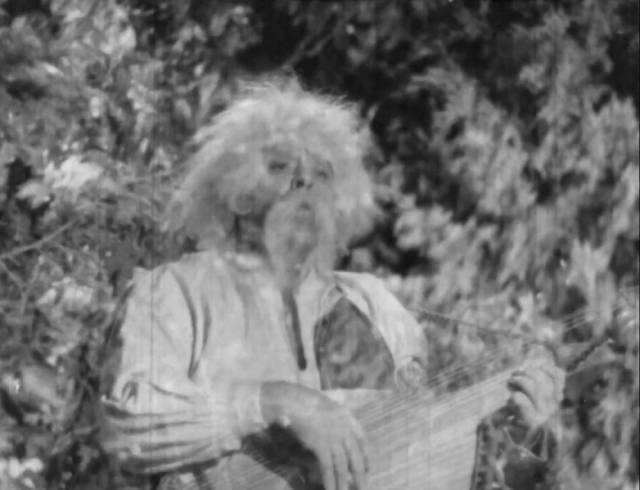
They say history doesn’t repeat, but it does rhyme – and sometimes those rhymes echo in odd and unexpected places. After my recent post about Edgar G. Ulmer, my friend John Paskievich sent me a YouTube link to an Ulmer movie I knew nothing about. Cossacks in Exile (1938) was one of a series of low budget films Ulmer made for independent producers tailored for underserved audiences, most famously four Yiddish features shot in rural New Jersey in the late 1930s and the “race drama” Moon Over Harlem (1939). News to me was that he had also made two Ukrainian-language movies during the same period, Natalka Poltavka (1937) and Cossacks in Exile, both musicals.
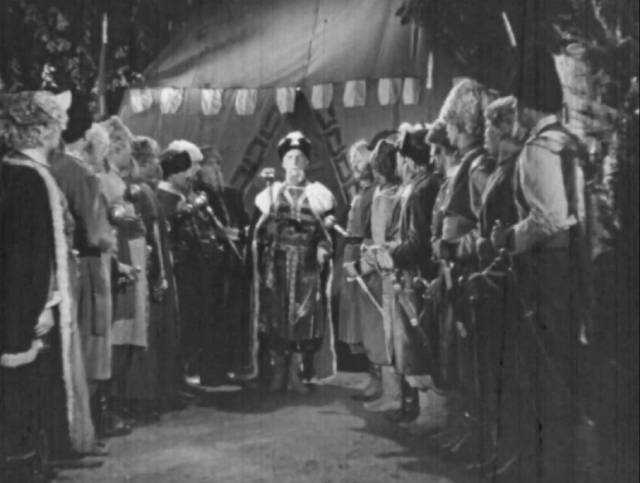
The quality of the video on YouTube was pretty bad but since it was preceded by a note indicating that it had been uploaded by the Provincial Archives of Alberta, I contacted them and quickly received a very helpful response. If I was willing to wait, they’d attempt to create a higher quality copy for me. And four weeks later I was sent a link to a new upload, which was a definite improvement in terms of technical quality – a brighter, sharper image with decent contrast compared to the original dark and murky image – but naturally the source was still severely compromised, with a dense layer of scratches and multiple breaks with missing frames. Still, it was watchable.
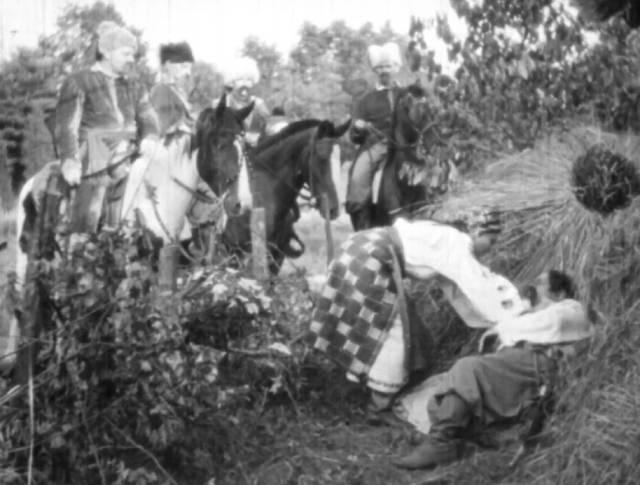
Based on an operetta by Semyon Artemovsky, the movie tells the story of a lazy man named Ivan Karas (Michael Shvetz), henpecked by his wife Odarka (Maria Sokil) until circumstances conspire to make him a leader of his community. Much of the story is played as light comedy, but the background is considerably darker. As the film opens, this community of Cossacks live an independent life in Ukraine; when the Tsarina Catherine II sends emissaries to demand that the Cossacks submit to Russian authority, they refuse and she dispatches her army to destroy their fortified town, driving the survivors into exile in Turkey.
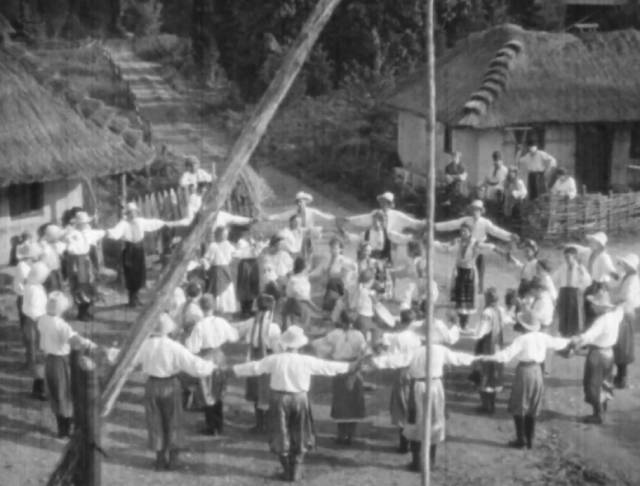
The exiles having provided their military services to the Turkish ruler, the Sultan (Nicholas Harlash) rides to their village to express his gratitude – but when he meets Ivan, he conceals his identity and fishes for the Cossack’s opinion of their Turkish host. Having received some indirect compliments, he has one of his aides invite Ivan to the capital to meet the Sultan. This concealing of identities is a generic element of the comedy which serves chiefly to keep the slight story moving, without producing any real dramatic complications. The main point is to generate a sympathetic personal connection between the leader of the Cossacks and the Sultan, which pays off at the end.
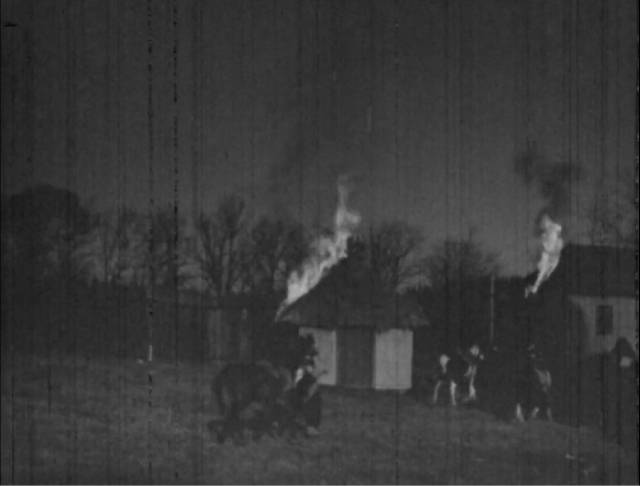
The final act revolves around a secondary story. A young woman named Oksana (Helen Orlenko) loves Andrey (Alexis Tcherkasshy), but is pestered by Prokip (S. Mostowy). Separated in exile, Oksana waits for Andrey to reappear, and when he finally does Prokip kills a Turkish soldier and frames Andrey. The authorities are about to hang him when the Sultan arrives, announces that he has heard the whole story, frees Andrey and has Prokip arrested. At this point things got a bit confusing for me because Ivan takes the opportunity to ask the Sultan’s permission for the Cossacks to return to their Ukrainian homeland – but surely the problem isn’t the Turkish ruler but the Tsarina?
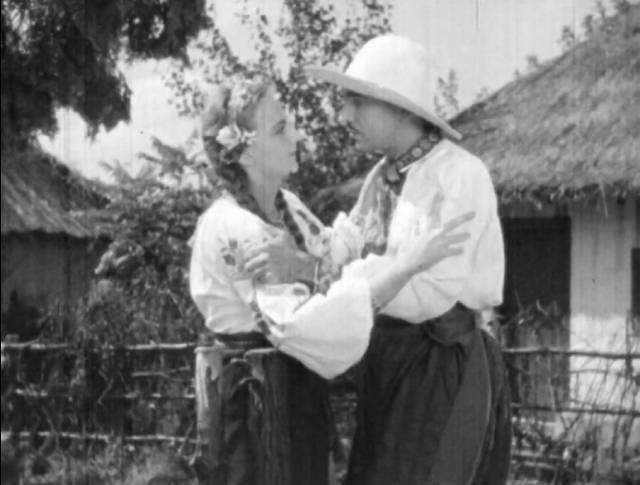
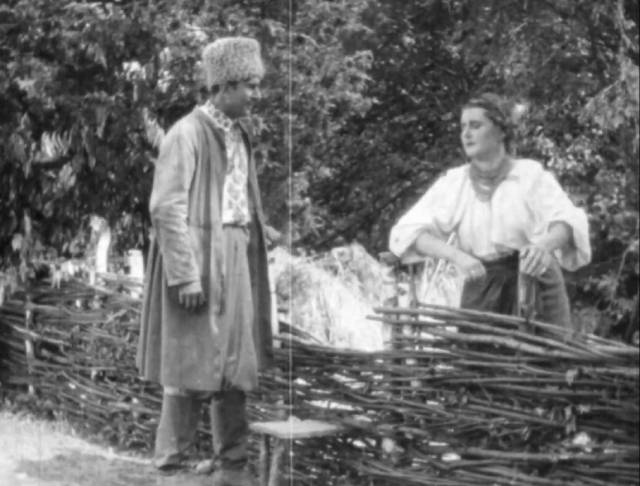
Although the narrative is simple enough to follow, details are obscured because for some reason while most of the dialogue is subtitled and occasional on-screen text fills in some of the background, none of the lengthy musical passages are, except for a handful of interludes with “the ageless bard” who serves as a chorus who comments on events. No doubt, as in any musical, these arias are mostly expressions of the characters’ emotional state and as such it’s easy enough to get the gist of what they’re singing, but it’s possible there are narrative details hidden to someone who doesn’t speak the language.
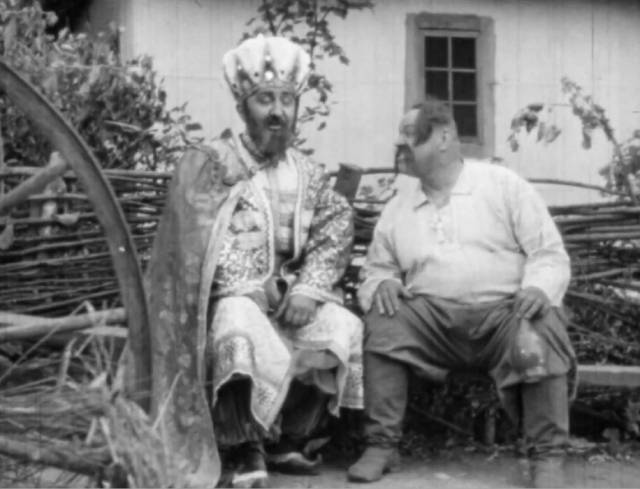
As is common with Ulmer, an inadequate budget is stretched as far as it can possibly go. An army is represented by a few horsemen, a fortified town by a few thatched cottages. He keeps the focus on a handful of characters to sidestep the absence of sufficient extras to suggest the scale implied by the story. As with the Yiddish features, the movie exists to serve viewers in a particular community which seldom saw itself on screen, a community which would no doubt bring an awareness of cultural and historical details the film itself couldn’t supply.
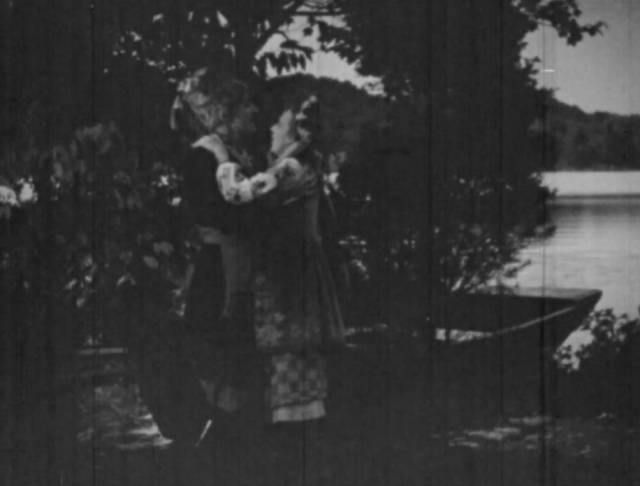
I had only a vague idea of who the Cossacks were and that was kind of negative – that they were associated with various pogroms in the Russian empire (Ensign Chekov in Star Trek would use the word as a contemptuous epithet) – so I had to do a little research to discover that for a long time they had been semi-nomadic warriors who provided military services to various nations while maintaining their own independence. As with many peoples not rooted to a particular piece of land, the formation and growth of more firmly defined states imposed increasing constraints on their independence – hence the events behind this movie, with Catherine seeking to subsume them under her empire’s military, and their acceptance in the Ottoman Empire to which they subsequently provided military service.
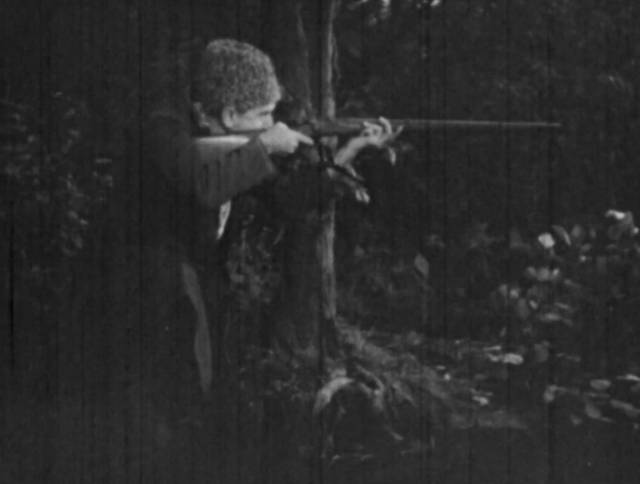
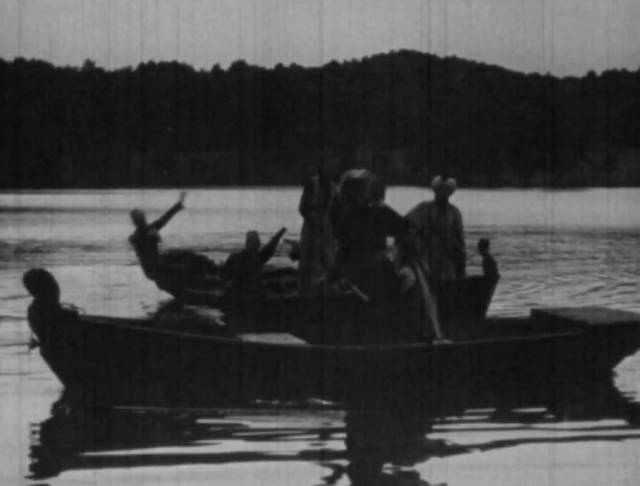
Catherine’s assertion of rule over the Cossacks in Ukraine finds echoes two-hundred-and-fifty years later in Putin’s claim that Ukraine rightfully belongs to Russia; her military action against them prefigures the present invasion and uprooting of the Ukrainian population, driving large numbers of civilian refugees to the West. But perhaps the most striking echo lies in the fact that the fortified town destroyed by Catherine’s army was the Zaporozhian Sich, located where the endangered Zaporizhzhya nuclear power plant is now under assault by Putin’s army.
*
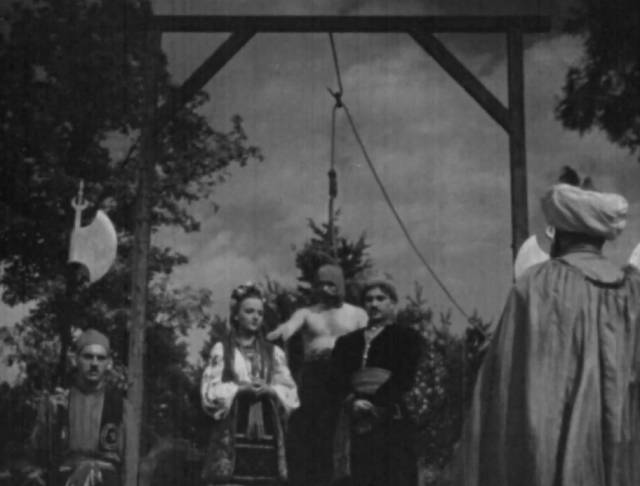
From a local perspective, there’s one more point of interest about Ulmer’s Cossacks in Exile. It was produced by a colourful, slightly shady man named Vasyl Avramenko. Born in Ukraine in 1895, he became a homeless orphan wandering through Russia, eventually joined the Russian navy, then the army. Having fought and been wounded in the First World War, he was caught up in the post-Revolutionary war between the Communists and the White Russians. Having become interested in traditional Ukrainian dance, he set up a dance school in the prison camp where he was interned and eventually his reputation spread. In subsequent years, he travelled and gave performances reinforcing dance as an expression of Ukrainian identity. Then in 1925 he emigrated to Canada and began to tour to raise awareness of the situation back home, promoting the idea of Ukrainian independence. This project eventually led to him establishing a dance school in Winnipeg, the city being an important centre of the Ukrainian immigrant community which was spread across the prairies.
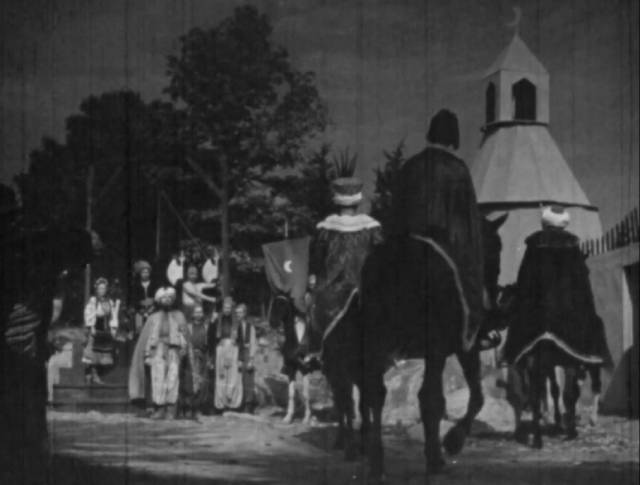
Avramenko quickly set up numerous dance schools in the prairie provinces, and then moved to the States to spread the word more widely. This expansion caused him financial problems and he eventually used dubious methods to raise money, particularly after a visit to Hollywood gave him the idea of getting into movie production, which he would finance largely through small donations from members of the widely scattered Ukrainian community. Eventually, he put together three features and a documentary between 1937 and 1940, including the two musicals directed by Ulmer, which much to the director’s irritation Avramenko claimed the credit for making.
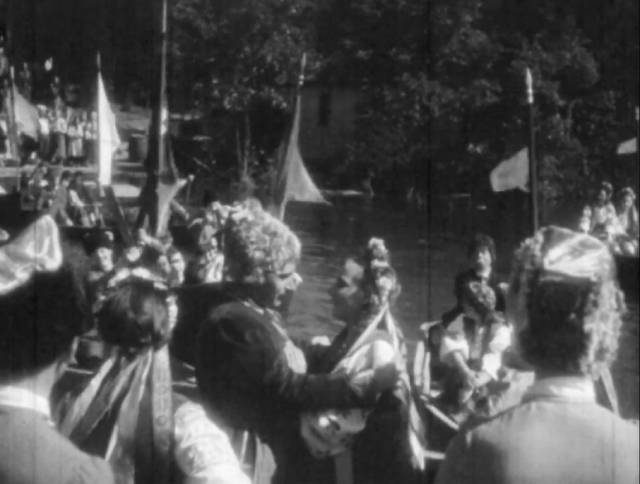
The print used as a source by the Provincial Archives of Alberta was part of a collection donated by Andrij Baziuk consisting of features, shorts, trailers and newsreels which had been used in travelling movie shows touring around Saskatchewan from the ’30s to the ’50s, which would explain the sorry state of the print. But I’m grateful that some effort has been made to preserve the film and make it available. This illuminates yet another odd niche in the eclectic career of one of my favourite directors.
Comments